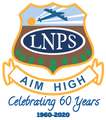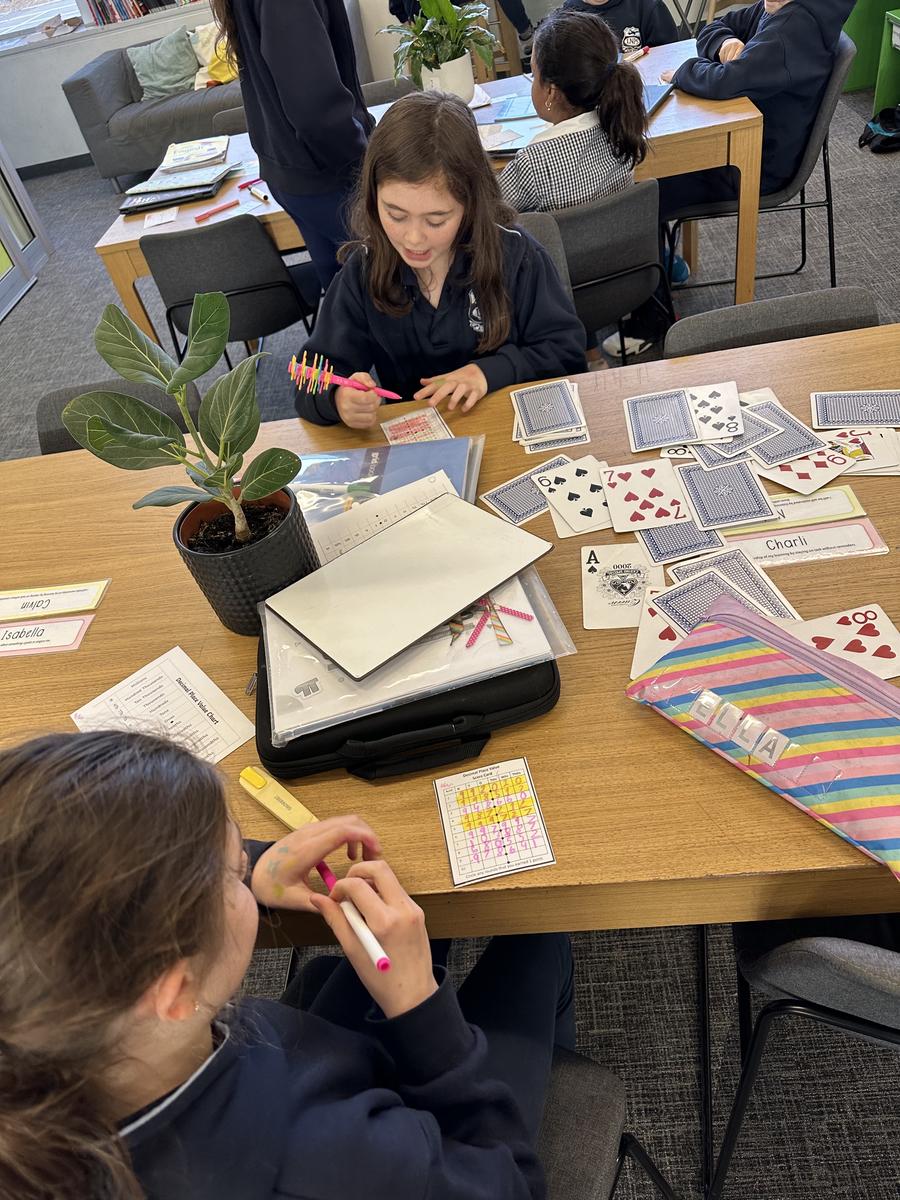MATHS

This semester in Maths we are learning about the four operations, patterns and algebra, measurement, decimals, fractions and percentages, statistics and probability, data representation and interpretation and area, volume and capacity.
Year 4 - Patterns and Algebra
Learning Intentions:
- We are learning different strategies for finding unknown quantities
In this unit, students will:
- describe and continue number patterns resulting from performing multiplication
- solve word problems using number sentences involving multiplication and division
- know of and explain different strategies for finding unknown quantities in number sentences (for example, partitioning)
Achievement Standards:
Students will choose appropriate strategies for calculations involving multiplication and division. They identify and explain strategies for finding unknown quantities in number sentences. They describe number patterns resulting from multiplication. They continue number sequences involving multiples of single digit numbers.
Year 4 - Measurement
Learning Intentions:
- We are learning to recognise attributes that can be measured
- We are learning how units of measure are used and calculated
In this unit, students will:
- use non-standard units and scaled instruments effectively, including reading and interpreting graduated scales on a range of tools to the nearest graduation
- recognise the connection between length and perimeter and that they are a measure of 1 dimension, and identify methods to measure the perimeter of shapes and spaces
- understand that area is the measure of a 2D shape and measure and compare the area of regular and irregular shapes in square units
- understand that volume is the measure of a 3D object and measure volume with familiar metric units, such as centicubes.
Achievement Standards:
Students will use scaled instruments to measure temperatures, lengths, shapes and objects.
Year 5 - Decimals, Fractions and Percentages
Learning intentions:
- We are learning about the relationship between decimals, fractions and percentages.
In this unit, students will:
- know the name of the place value for 3 digits after the decimal point, namely tenths, hundredths and thousandths.
- know that fractions are just different names for decimals and are able to recognise common fractions and decimal equivalents and estimate and compare their size
- compare, order and represent decimal fractions to thousandths
Achievement Standards:
Students will use place value students use place value to write and order decimals including decimals greater than one. They will represent common percentages and connect them to their fraction and decimal equivalents.
Year 4 - Statistics and Time
Learning Intentions:
- We are learning to describe data
- We are learning to critically evaluate data
In this unit, students will:
- interpret a range of graphs and identify the information being communicated
- know the features of common graphs, including column and picture graphs
- know a variety of data displays and evaluate the effectiveness of them
- know how to convert between seconds, minutes, and hours
- use ‘am’ and ‘pm’ notations and solve simple time problems.
Achievement Standards:
Students will convert between units of time. They describe different methods for data collection and representation and evaluate their effectiveness. They construct data displays from given or collected data.
Year 5 Measurement – Conversion of units, area, volume and capacity
Learning Intentions:
- We are learning about measurement.
In this unit, students will:
- understand that there are a range of methods to find the perimeter and/or area of a rectangle and know which method is most efficient.
- understand that measurement involves comparing an attribute of an item with a unit that shares the same attribute.
- know which units of measurement measure different attributes (for example cm2 and m2 measure area).
Achievement Standards:
Students will choose and use appropriate metric units to measure the attributes of length, mass and capacity, and to solve problems involving perimeter and area.
Year 5 - Shape, location, transformation and angles
Learning Intentions:
- We are learning about shape, location, transformation and angles.
In this unit, students will:
- recognise the connection between 2D and 3D shapes.
- know how to read, navigate, create and explore grid reference systems using map references.
- describe and identify transformations.
- understand the characteristics of angles and be able to estimate, measure and construct them.
Achievement standards:
Students will identify the mode and interpret the shape of distributions of data in context.
Year 5 - Statistics and Probability, and Data Representation and Interpretation on time
Learning Intentions:
- We are learning about statistics and probability.
- We are learning about data representation and interpretation.
In this unit, students will:
- be able to use content specific vocabulary to describe the likelihood of an event occurring.
- identify all possible outcomes of a chance experiment.
- understand that probability ranges from 0-1 and use a number line to represent the likelihood of a range of events.
- assess the likelihood and fairness of winning simple chance games using probability vocabulary and fractions.
- identify data as either categorical or numerical, and understand that graphical representations and results vary depending on the type of data
- understand that collecting data requires a purpose and formulate appropriate questions to collect data
- construct and interpret a range of data through tables and graphs.
Achievement standards:
They will plan and conduct statistical investigations that collect nominal and ordinal categorical and discrete numerical data using digital tools. They will interpret and compare data represented in line graphs. Students will conduct repeated chance experiments, list the possible outcomes, estimate likelihoods and make comparisons between those with and without equally likely outcomes.
Year 6 - Fractions, Decimals, and Percentages
Learning Intentions:
- We are learning about the relationship between fractions, decimals, and percentages.
In this unit, students will:
- explore the connection between fractions, decimals, and percentages.
- record decimal fractions as percentages.
- order and compare numbers with decimal parts.
- apply known strategies of addition and subtraction to seek solutions.
- build understanding of benchmark percentages and the connection to fractions and decimals.
- understand how benchmark percentages have fraction and decimal equivalents.
- apply strategies to solve problems.
- use critical and creative thinking to relate familiar fractions with decimals and percentages.
- express decimals as a way of writing fractions within the base-ten system.
- record decimal fractions as percentages.
- identify how decimals are fractions and how these different representations express the same amount.
- rename decimal values in place value parts.
- use critical and creative thinking to order decimals by size and round decimals to the nearest place value.
- apply known strategies of addition and subtraction to seek solutions.
- explore estimations and use critical and creative thinking to deduce strategies and find solutions when multiplying with decimals.
- apply the inverse relationship of multiplication and use proportional reasoning to find solutions when dividing with decimals.
- investigate benchmark percentages of real-world scenarios and will apply strategies to solve problems.
Achievement Standards:
Students connect fractions, decimals, and percentages as different representations of the same number. They solve problems involving the addition and subtraction of related fractions.
Year 6 - Probability and Data Investigation and Interpreting
Learning Intentions:
- We are learning to interpret and compare data displays. We are learning to understand probability.
In this unit, students will:
- understand that the choice of graphical representation can affect how well the data is understood.
- construct a range of data displays.
- establish the mean in a set of data.
- identify 2 types of data including categorical and numerical, they will pose questions in order to collect these 2 types.
- use number lines to order probabilities of outcomes
- describe probabilities using fractions, decimals, and percentages
- conduct chance experiments and analyse the variance in results between a small and large number of trials.
Achievement Standards:
Students compare observed and expected frequencies. They interpret and compare a variety of data displays including those displays for two categorical variables. They interpret secondary data displayed in the media.
Year 6 - Area, Volume and Capacity
Learning Intentions:
- We are learning about area, volume and capacity.
In this unit, students will:
- understand that our metric system is connected to decimal representation
- know which operation to use when converting between common metric units of length, mass, and capacity and will convert between them
- choose appropriate units of measurement to perform calculations
- solve problems involving height and area
- make connections between volume and capacity.
Achievement Standard
They make connections between capacity and volume. They solve problems involving length and area.
Year 6 - Shape, Locations, Transformations and Angles
Learning Intentions:
- We are learning about shape, locations, transformations and angles.
In this unit, students will:
- know the similarities and differences between prisms and pyramids.
- locate an ordered pair on the Cartesian plane and describe the features of a Cartesian plane.
- understand that the Cartesian plane provides a visual way of describing a location.
- know the different types of transformations (including translation, rotation and reflection).
- solve problems using the properties of angles including: angles on a line, angles at a point and vertically opposite angles.
Achievement Standards:
Students locate an ordered pair in any one of the four quadrants on the Cartesian plane. They construct simple prisms and pyramids.
Students describe combinations of transformations. They solve problems using the properties of angles.





